- Home
- J. G. Ballard
The Atrocity Exhibition Page 4
The Atrocity Exhibition Read online
Page 4
Idiosyncrasies and Sin-crazed Idioms. As she leaned against the concrete parapet of the camera tower, Catherine Austin could feel Koester's hands moving around her shoulder straps. His rigid face was held six inches from her own, his mouth like the pecking orifice of some unpleasant machine. The planes of his cheekbones and temples intersected with the slabs of rain-washed cement, together forming a strange sexual modulus. A car moved along the perimeter of the test area. During the night the students had built an elaborate tableau on the impact site fifty feet below, a multi-vehicle auto-crash. A dozen wrecked cars lay on their sides, broken fenders on the grass verges. Plastic mannequins had been embedded in the interlocked windshields and radiator grilles, wound areas marked on their broken bodies. Koester had named them: Jackie, Ralph, Abraham. Perhaps he saw the tableau as a rape? His hand hesitated on her left breast. He was watching the Novotny girl walking along the concrete aisle. She laughed, disengaging herself from Koester. Where were her own wound areas?
Speed Trials. Talbot opened the door of the Lincoln and took up his position in agent Greer's seat. Behind him the helicopter pilot and the young woman sat in the rear of the limousine. For the first time the young woman had begun to smile at Talbot, a soundless rictus of the mouth, deliberately exposing her wound as if showing him that her shyness had gone. Ignoring her now, Talbot looked out through the dawn light at the converging concrete aisles. Soon the climax of the scenario would come, JFK would the again, his young wife raped by this conjunction of time and space. The enigmatic figure of Nader presided over the collision, its myths born from the cross-overs of auto-crashes and genitalia. He looked up from the wheel as the flares illuminated the impact zone. When the car surged forward he realized mat the two passengers had gone.
The Acceleration Couch. Half zipping his trousers, Koester lay back against the torn upholstery, one hand still resting on the plump thigh of the sleeping young woman. The debris-filled compartment had not been the most comfortable site. This zombie-like creature had strayed across the concrete runways like a fugitive from her own dreams, forever talking about Talbot as if unconsciously inviting Koester to betray him. Why was she wearing the Jackie Kennedy wig? He sat up, trying to open the rusty door. The students had christened the wreck ‘Dodge 38’, furnishing the rear seat with empty beer bottles and contraceptive wallets. Abruptly the car jolted forward, throwing him across the young woman. As she woke, pulling at her skirt, the sky whirled past the frosted windows. The clanking cable between the rails propelled diem on a collision course with a speeding limousine below the camera tower.
Celebration. For Talbot the explosive collision of the two cars was a celebration of the unity of their soft geometries, the unique creation of the pudenda of Ralph Nader. The dismembered bodies of Karen Novotny and himself moved across the morning landscape, re-created in a hundred crashing cars, in the perspectives of a thousand concrete embankments, in the sexual postures of a million lovers.
Interlocked Bodies. Holding the bruise under his left nipple, Dr Nathan ran after Webster towards the burning wrecks. The cars lay together at the centre of the collision corridor, the last steam and smoke lifting from their cabins. Webster stepped over the armless body of Karen Novotny hanging face-down from the rear window. The burning fuel had traced a delicate lacework of expressed tissue across her naked thighs. Webster pulled open the rear door of the Lincoln. ‘Where the hell is Talbot?’ Holding his throat with one hand, Dr Nathan stared at the wig lying among the beer bottles.
The Helicopters are Burning. Talbot followed the young woman between the burning helicopters. Their fuselages formed bonfires across the dark fields. Her strong stride, with its itemized progress across the foam-smeared concrete, carried within its rhythm a calculated invitation to his own sexuality. Talbot stopped by the burning wreck of a Sikorsky. The body of Karen Novotny, with its landscapes of touch and feeling, clung like a wraith to his thighs and abdomen.
Fractured Smile. The hot sunlight lay across the suburban street. From the radio of the car sounded a fading harmonic. Karen Novotny's fractured smile spread across the windshield. Talbot looked up at his own face mediated from the billboard beside the car park. Overhead the glass curtain-walls of the apartment block presided over this first interval of neural calm.
The Conceptual Death.
Experiments often test the experimenter more than the subject One remembers the old joke about the laboratory rat who said: ‘I have that scientist trained – every time I press this lever he gives me a pellet of food.’ For me, the most interesting aspect of the work of Masters and Johnson, collected in Human Sexual Response, was its effect on themselves. How were their sex lives influenced, what changes occurred in their sexual freedoms and fantasies? In conversation they seemed almost neutered by the experiments. I suspect that the copulating volunteers were really training the good doctors to lose all interest in sex, just as computerized diagnostic machines, where patients press buttons in reply to stock questions, are inadvertently training them to develop duodenal ulcers or varicose veins.
Talbot Another face of the central character of The Atrocity Exhibition. The core identity is Traven, a name taken consciously from B. Traven, a writer I've always admired for his extreme reclusiveness – so completely at odds with the logic of our own age, when even the concept of privacy is constructed from publicly circulating materials. It is now almost impossible to be ourselves except on the world's terms.
Obscene Mannequin.
The time-music of the quasars. A huge volume of radio signals reaches this planet from space, crossing gigantic distances from the far side of the universe. It's hard to accept that these messages are meaningless, as they presumably are, no more than the outward sign of nuclear processes within the stars. Yet the hope remains that one day we will decode them, and find, not some intergalactic fax service, but a spontaneously generated choral music, a naive electro-magnetic architecture, the primitive syntax of a philosophical system, as meaningless but as reassuring as the pattern of waves on a beach.
Reassembling the furniture of his mind, Talbot has constructed a primitive antenna, and can now hear the night sky singing of time, the voice of the unseen powers of the cosmos.
A Sophisticated Entertainment.
Has a festival of atrocity films ever been held? Every year at the Oscars ceremony, some might say. It seemed likely in the late 60s, but the new puritans of our day would greet such a suggestion with a shudder. A pity – given the unlimited opportunities which the media landscape now offers to the wayward imagination, I feel we should immerse ourselves in the most destructive element, ourselves, and swim. I take it that the final destination of the 20th century, and the best we can hope for in the circumstances, is the attainment of a moral and just psycho pathology.
The Image Maze.
After a dinner party in the 1970s t almost came to blows with a prominent New York poet (in fact, I tried playfully to run him down with my car, if such an act can be playful). He had derided my observation that cruel and violent images which elicit pity one day have by the next afternoon been stylised into media emblems. Yet the tragic photograph of the Saigon police chief shooting a Viet Cong suspect in the head was soon used by the London Sunday Times as a repeated logo keying its readers to Vietnam features in the paper. If I remember, the tilt of the dying man's head was slightly exaggerated, like a stylized coke bottle or tail-fin.
Towards the D.M.Z.
Max Ernst's paintings run through The Atrocity Exhibition, in particular ‘The Eye of Silence’ and ‘Europe After the Rain.’ Their clinker-like rocks resemble skeletons from which all organic matter has been leached, all sense of time. Looking at these landscapes, it's impossible to imagine anything ever happening within them. The neural counterparts of these images must exist within our brains, though it's difficult to guess what purpose they serve.
Mimetized Disasters.
Most of the machines that surround our lives – airliners, refrigerators, cars and typewriters –
have streamlined their way into our affections Now and then, as in the case of the helicopter, with its unstable, insect-like obsessiveness, we can see clearly the deep hostility of the mineral world. We are lucky that the organic realm reached the foot of the evolutionary ladder before the inorganic.
The Persistence of Memory.
Dali's masterpiece, and one of the most powerful of all surrealist images.
The Plaza.
Dealey Plaza in Dallas, re-imagined in Talbot's eye as the end of the world.
The Annunciation.
Nader has only just survived into the 1990s, and it's difficult now to imagine his name leaping to anyone's lips, but at the time he sent a seismic tremor through the mind of the US consumer, challenging the authority of that greatest of all American icons, the automobile. Every car crash seemed a prayer to Ralph Nader.
Stochastic Analysis.
Believe it or not some researcher did carry out a stochastic analysis of the Pentagon car park, translating the guesstimated flow-patterns of vehicles into a three-dimensional volume graph.
Crash Magazine.
This was written two years before my 1969 exhibition of crashed cars. Scouring the wreckers' yards around London. I was unable to find a crashed Lincoln Continental, perhaps fortunately. As it was, the audience reaction to the telescoped Pontiac, Mini and Austin Cambridge verged on nervous hysteria, though had the cars been parked in the street outside the gallery no one would have given them a glance or devoted a moment's thought to the injured occupants. In a calculated test of the spectators, I hired a topless girl to interview the guests on closed-circuit TV. She had originally agreed to appear naked, but on seeing the cars informed me that she would only appear topless – an interesting logic was at work there. As the opening night party deteriorated into a drunken brawl she was almost raped in the back seat of the Pontiac, and later wrote a damning review of the show in the underground paper Friendz. The cars were exhibited without comment but during the month-long show they were continually attacked by visitors to the gallery, who broke windows, tore off wing mirrors, splashed them with white paint The overall reaction to the experiment convinced me to write Crash, in itself a considerable challenge to most notions of sanity.
I'm told that cars purporting to be the JFK Continental are often exhibited in the United States, and that a white Continental claiming to be the car in which Kennedy met his death was recently the centrepiece of a small museum on the causeway leading to Cocoa Beach, Florida.
The Optimum Wound Profile.
In February 1972, two weeks after completing Crash, I was involved in my only serious car accident After a front wheel blowout my Ford Zephyr veered to the right crossed the central reservation (I received a bill for the demolished sign, and was annoyed to see later that I had paid for a more advanced model, with flashing lights), and then rolled over and continued upside-down along the oncoming lane. Fortunately I was wearing a seat belt and no other vehicle was involved. An extreme case of nature imitating art. Curiously, before the accident and since, I have always been a careful and even slow driver, frequently egged on by impatient women-friends.
Unusual Poses.
Abraham Zapruder was a tourist in Dealey Plaza whose amateur cine-film captured the President's tragic death. The Warren Commission concluded that frame 210 recorded the first rifle shot which wounded Kennedy in the neck, and that frame 313 recorded the fatal head wound. I forget the significance of frame 230.
The Warren Commission's Report is a remarkable document, especially if considered as a work of fiction (which many experts deem it largely to be). The chapters covering the exact geometric relationships between the cardboard boxes on the seventh floor of the Book Depository (a tour de force in the style of Robbe-Grillet), the bullet trajectories and speed of the Presidential limo, and the bizarre chapter titles – ‘The Subsequent Bullet That Hit,’ ‘The Curtain Rod Story,’ ‘The Long and Bulky Package’ – together suggest a type of obsessional fiction that links science and pornography. One shudders to think how the report's authors would have dealt with any sexual elements, particularly if they had involved Jacqueline Kennedy (perhaps The Atrocity Exhibition fills that gap), or how their successors might have coped with the assassination of Vice-President Quayle and his evangelist wife in a hotel suite – say in Miami, a good city in which to be assassinated, within sight of those lovely banyan trees in Coral Gables, ambling pelicans and the witty Arquitectonica building.
Speed Trials.
Special Agent William R Greer of the Secret Service was the driver of the Presidential limousine. One can't help wondering how the events in Dealey Plaza affected him. Has his sense of space and time been altered? What role in his imagination is played by the desperate widow? The facilities exist for a complete neuro-psychiatric profile, though one will never be carried out The results would be interesting, since we were all in a sense in the driver's seat on that day in Dallas.
CHAPTER THREE
THE ASSASSINATION WEAPON
Thoracic Drop. The spinal landscape, revealed at the level of T-12, is that of the porous rock towers of Tenerife, and of the native of the Canaries, Oscar Dominguez, who created the technique of decalcomania and so exposed the first spinal landscape. The clinker-like rock towers, suspended above the silent swamp, create an impression of profound anguish. The inhospitability of this mineral world, with its inorganic growths, is relieved only by the balloons flying in the clear sky. They are painted with names: Jackie, Lee Harvey, Malcolm. In the mirror of this swamp there are no reflections. Here, time makes no concessions.
Autogeddon. Waking: the concrete embankment of a motorway extension. Roadworks, cars drumming two hundred yards below. In the sunlight the seams between the sections are illuminated like the sutures of an exposed skull. A young woman stands ten feet away from him, watching with unsure eyes. The hyoid bone in her throat flutters as if discharging some subvocal rosary. She points to her car, parked off the verge beside a grader, and then beckons to him. Kline, Coma, Xero. He remembered the aloof, cerebral Kline and their long discussions on tins terminal concrete beach. Under a different sun. This girl is not Coma. ‘My car.’ She speaks, the sounds as dissociated as the recording in a doll. ‘I can give you a lift. I saw you reach the island. It's like trying to cross the Styx.’
Googolplex. Dr Nathan studied the walls of the empty room. The mandalas, scored in the white plaster with a nail file, radiated like suns towards the window. He peered at the objects on the tray offered to him by the nurse. ‘So, these are the treasures he has left us – an entry from Oswald's Historic Diary, a much-thumbed reproduction of Magritte's “Annunciation”, and the mass numbers of the first twelve radioactive nuclides. What are we supposed to do with them?’ Nurse Nagamatzu gazed at him with cool eyes. ‘Permutate them, doctor?’ Dr Nathan lit a cigarette, ignoring the explicit insolence. This elegant bitch, like all women she intruded her sexuality at the most inopportune moments. One day … He said, ‘Perhaps. We might find Mrs Kennedy there. Or her husband. The Warren Commission has reopened its hearing, you know. Apparently it's not satisfied. Quite unprecedented.’ Permutate them? The theoretical number of nucleotide patterns in DNA was a mere 10 to the power of 120,000. What number was vast enough to contain all the possibilities of those three objects?
Jackie Kennedy, your eyelids deflagrate. The serene face of the President's widow, painted on clapboard four hundred feet high, moves across the rooftops, disappearing into the haze on the outskirts of the city. There are hundreds of the signs, revealing Jackie in countless familiar postures. Next week there may be an SS officer, Beethoven, Christopher Columbus or Fidel Castro. The fragments of these signs litter the suburban streets for weeks afterwards. Bonfires of Jackie's face burn among the reservoirs of Staines and Shepperton. With luck he finds a job on one of the municipal disposal teams, warms his hands at a brazier of eyes. At night he sleeps beneath an unlit bonfire of breasts.
Xero. Of the three figures who were to accompany him, the s
trangest was Xero. For most of the time Kline and Coma would remain near him, sitting a few feet away on the embankment of the deserted motorway, following in another car when he drove to the radio-observatory, pausing behind him as he visited the atrocity exhibition. Coma was too shy, but now and then he would manage to talk to Kline, although he never remembered what they said to each other. By contrast, Xero was a figure of galvanic energy and uncertainty. As he moved across the abandoned landscape near the overpass, the perspectives of the air seemed to invert behind him. At times, when Xero approached the forlorn group sitting on the embankment, his shadows formed bizarre patterns on the concrete, transcripts of cryptic formulae and insoluble dreams. These ideograms, like the hieroglyphs of a race of blind seers, remained on the grey concrete after Xero had gone, the detritus of this terrifying psychic totem.
Questions, always questions. Karen Novotny watched him move around the apartment, dismantling the mirrors in the hall and bathroom. He stacked diem on the table between the settees in the lounge. This strange man, and his obsessions with time, Jackie Kennedy, Oswald and Eniwetok. Who was he? Where had he come from? In the three days since she had found him on the motorway she had discovered only that he was a former H-bomber pilot, for some reason carrying World War III in his head. ‘What are you trying to build?’ she asked. He assembled the mirrors into a box-like structure. He glanced up at her, face hidden by the peak of his Air Force cap. ‘A trap.’ She stood beside him as he knelt on the floor. ‘For what? Time?’ He placed a hand between her knees and gripped her right thigh, handhold of reality. ‘For your womb, Karen. You've caught a star there.’ But he was thinking of Coma, waiting with Kline in the espresso bar, while Xero roamed the street in his white Pontiac. In Coma's eyes runes glowed.

 High-Rise
High-Rise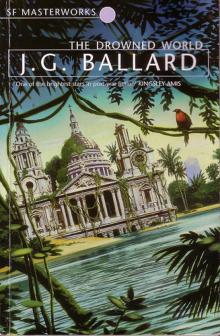 The Drowned World
The Drowned World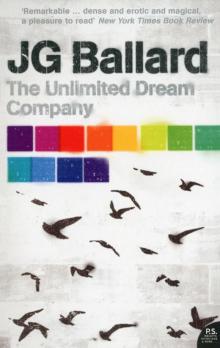 The Unlimited Dream Company
The Unlimited Dream Company Running Wild
Running Wild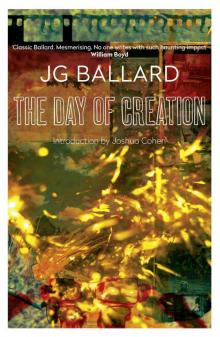 The Day of Creation
The Day of Creation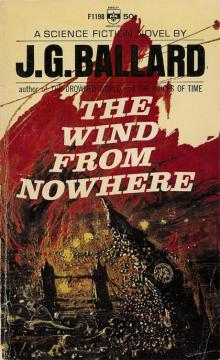 The Wind From Nowhere
The Wind From Nowhere The Complete Short Stories, Volume 2
The Complete Short Stories, Volume 2 Concrete Island
Concrete Island Empire of the Sun
Empire of the Sun The Kindness of Women
The Kindness of Women Vermilion Sands
Vermilion Sands Super-Cannes
Super-Cannes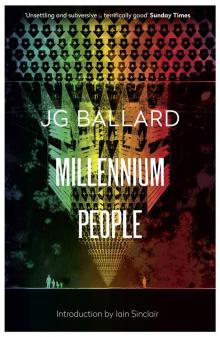 Millennium People
Millennium People The Complete Stories of J. G. Ballard
The Complete Stories of J. G. Ballard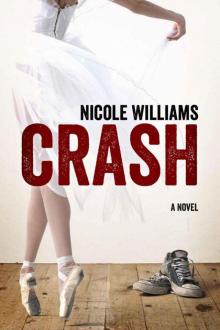 Crash
Crash The Drought
The Drought The Atrocity Exhibition
The Atrocity Exhibition The Complete Short Stories: Volume 1
The Complete Short Stories: Volume 1 Miracles of Life: Shanghai to Shepperton: An Autobiography
Miracles of Life: Shanghai to Shepperton: An Autobiography Rushing to Paradise
Rushing to Paradise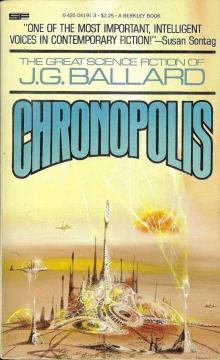 Chronopolis
Chronopolis Cocaine Nights
Cocaine Nights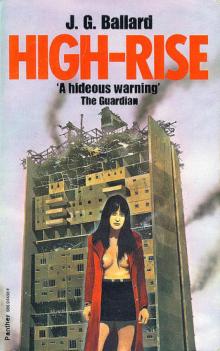 High Rise (1987)
High Rise (1987) The Complete Short Stories
The Complete Short Stories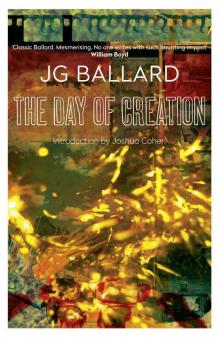 The Day of Creation (Harper Perennial Modern Classics)
The Day of Creation (Harper Perennial Modern Classics) The Crystal World
The Crystal World